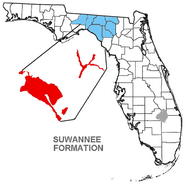Suwannee Limestone facts for kids
Quick facts for kids Suwannee LimestoneStratigraphic range: Oligocene |
|
|---|---|
| Type | Geological formation |
| Underlies | Hawthorn Group-Arcadia Formation |
| Overlies | Ocala Limestone |
| Thickness | 160 ft (49 m) |
| Lithology | |
| Primary | Limestone |
| Location | |
| Region | North Florida |
| Country | |
| Extent | Leon to Hamilton to Taylor counties |
| Type section | |
| Named for | Suwannee River |
| Named by | C.W. Cooke and W.C. Mansfield |
The Suwannee Limestone is a type of limestone rock. It is a geologic formation found in North Florida, United States. This rock layer formed a long time ago, during the Oligocene Epoch. That was about 23 to 34 million years ago.
Contents
Where to Find Suwannee Limestone
The Suwannee Limestone is found in many parts of Florida. You can see it where the rock comes to the surface. These areas are mostly in the northwestern, northeastern, and southwestern parts of Florida's peninsula.
Location Details
This limestone is found in several counties. These include Leon, Jefferson, Madison, and Taylor counties. It is also found in Lafayette and Hamilton counties. You can see it along the upper Suwannee River basin. It also stretches south into Suwannee County, Florida.
Why It's Not Everywhere
The Suwannee Limestone is not found in all areas. For example, it is missing from a place called Orange Island. This area is on the eastern side of the Ocala Platform. The Ocala Platform is a large, underground rock structure. The limestone might be missing because it was worn away by water or wind. It also might not have been deposited there in the first place.
What Suwannee Limestone Looks Like
Suwannee Limestone is usually white or cream-colored. It can be soft or very hard. It often has many holes and spaces where fossils used to be. This type of rock is called a grainstone or packstone. This means it is made of grains and pieces of shells.
Dolomite in the Limestone
Sometimes, parts of the Suwannee Limestone have changed into another rock called dolomite. These parts are often gray, tan, or brown. They are usually hard and made of small or large crystals. These dolomite parts sometimes still have fossils in them. You can also find silicate minerals mixed in with the limestone.
How Suwannee Limestone Fits In
The Suwannee Limestone sits on top of another older rock layer. This layer is called the Ocala Limestone. The Suwannee Limestone is part of an important system. This system helps to hold and move underground water. It acts like a sponge, storing water for us to use.
Ancient Life in the Suwannee Limestone
The Suwannee Limestone is full of fossils! These fossils tell us about the ancient life that lived in the seas millions of years ago. Scientists study these fossils to learn about Earth's past.
Types of Fossils Found
- Foraminifers: These are tiny, single-celled creatures. They often have shells.
- Echinoids: These are like ancient sea urchins or sand dollars.
- Bryozoans: These are tiny animals that live in colonies. They often look like moss or coral.
- Mollusks: This group includes ancient snails, clams, and other shelled creatures.


